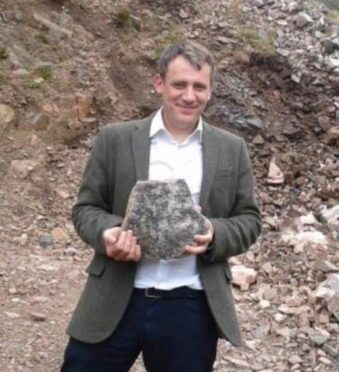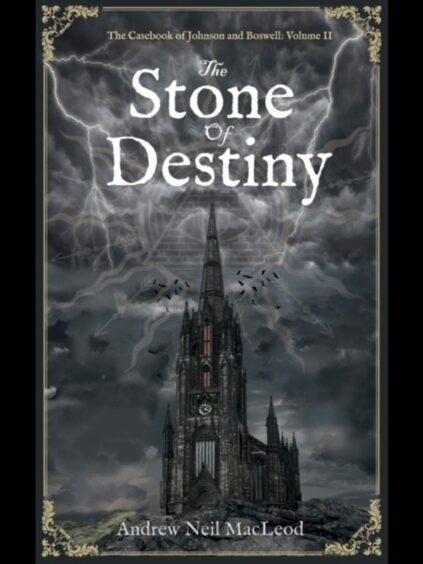While Andrew Neil MacLeod was growing up in Glasgow, the rich heritage of storytelling and poetry of the Inner Hebrides was always close. Here, the author tells us how that influence led to a series of historical stories based in 18th century Scotland.
Andrew credits his grandfather Calum, “a big man from the Isle of Raasay,” with his love of the written and spoken tale. “From him I inherited a love of Scottish history and Celtic myth, which forms the basis of my Casebook of Johnson and Boswell series, re-imagining the real-life 18th century heroes as a kind of Holmes and Watson of the supernatural.
“We would make up our own stories and poems together,” he says, “a habit that has continued into adulthood.”
The author’s latest novel, The Stone of Destiny, is the second volume in The Casebook of Johnson and Boswell, which reimagines the adventures of the famous Dr Samuel Johnson and his biographer James Boswell.
Andrew explains the origins of the series: “My wife Amber and I took a Highland road trip for our honeymoon, unwittingly following in the three-hundred year old footsteps of literary heroes Johnson and Boswell. We started from Edinburgh’s Witchery Hotel, which just so happens to be adjacent to James Boswell’s residence on the High Street, and finished at Raasay House, where Johnson and Boswell enjoyed the hospitality of clan chief John MacLeod during their 1773 tour of the Highlands.”
While staying at Raasay House, he found; “a mildewed copy of Doctor Johnson’s Journey to the Western Isles in the library of Raasay House, and after a hair-raising experience with the resident ghost, I was inspired to write my own series of books.
“I took my cue from Sir Arthur Conan Doyle’s A Scandal in Bohemia, in which Holmes describes Watson as ‘the Boswell to his Johnson’, re-inventing the two heroes as supernatural investigators of 18th century Scotland.”
Episodic tale
Andrew has presented The Stone of Destiny in episodic form and the novel has been described as an adventure within an adventure: think the Da Vinci Code or an Indiana Jones tale. “It’s an anthology of stories,” explains the author, “with the quest for the king-making stone of Scotland tying it all together. The two protagonists solve a series of puzzles, each bringing them to the next chapter or story, and closer to their prize. But of course they’re not the only ones looking.”
The choice of the Stone of Destiny was originally intended simply as a plot device but Andrew quickly became intrigued by the story of the stone itself. “The more I researched the subject, the more fascinating historical facts I uncovered. It’s a rare gift for a writer to find so much history shrouded in mystery, yet just enough facts to ground the whole thing in reality,” he enthuses.
The true stone?
The writer was gripped by the idea that the stone that now rests at Edinburgh Castle is not the true Stone of Destiny. “The true Stone of Destiny, the Palladium of Scotland, which was said to sing for joy whenever a true King of Scots was crowned, is depicted on ancient seals as a high seat or a chair, whereas medieval chroniclers describe a smooth block of black marble or meteorite, ornately carved into the shape of a throne,” he explains.
“And yet, if you visit the Stone at Edinburgh Castle, it’s the plainest piece of masonry you could possibly imagine, unremarkable in every way. Hard to believe it was the cause of so much contention and bloodshed. So what happened? The common theory is that Edward I, who took the Stone of Destiny back with him to England by force, was duped.”
A cludgie stane
Andrew believes that: “The evidence is compelling. On his march north it would take Longshanks several months to reach Scone Abbey, where the Stone was being held. Plenty of time, in other words, for the Abbot to substitute the true Stone for a forgery. Some say it was a cludgie stane that Edward dragged back with him to Westminster, which is the lid used to cover a toilet cistern. I must admit it does make me smile, the thought of Edward’s heirs being crowned on a toilet seat!”
He has taken this theory and run with it to produce a break-neck ride through the Highland and Lowlands of Scotland peppered with encounters with the occult and the supernatural.
Fans of the adventures of Johnson and Boswell will be pleased to hear that the next book is in the pipeline. “It might be the most ambitious yet,” reveals Andrew. “With a multiplicity of characters introduced in books one and two coming together for the denouement.”
The Stone of Destiny is published on October 31 and available to pre-order now. £12.99.











